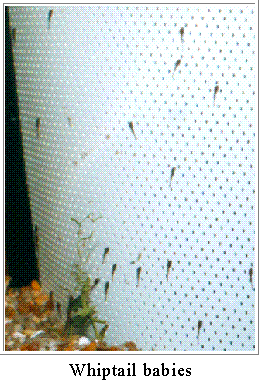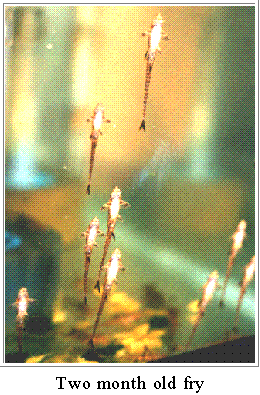INVASION OF THE WHIPTAILS
- page 2
wasn't eaten by the next day.
Father whiptail started spending a lot of his time inside the bamboo tube.
It must have been cramped because he couldn't completely spread his pectorals
in there. One day in early February mother whiptail was nowhere to be seen
in the tank. I got down and peered into the tube. Sure enough they were both
crammed into that impossibly small space. She stayed in there all day and,
as far as we know, most or all of the night. I was worried that they might
be stuck and unable to get out but the next day there she was munching on
a bean.
We couldn't get a good look at the eggs. All we could tell was that there
was something stuck to the inside of the tube that hadn't been there before
and that father whiptail was doing his best to keep water moving over its
surface. As far as we know he never came out, even to eat, for the next 14
days. |
|
On the 12th day several tiny black
whiptails were seen on the gravel and walls of the tank. By the end of the
14th day we had removed approx. 100 babies and father was out and
about looking for food.
The babies were housed in a 5 gallon tank filled with water from the hatching
tank with the addition of a well aged sponge filter. They were fed generous
amounts of baby brine shrimp twice a day supplemented by bits of crushed
green bean and some of our agar spirulina concoction.
 |
|
The lights have been kept off most of the time
and some water has been changed every day.
 Growth has been quite rapid and, as of this writing, they inhabit three larger tanks and some are ready for auction. If you like small, quiet, almost invisible algae eaters,
try them.
Growth has been quite rapid and, as of this writing, they inhabit three larger tanks and some are ready for auction. If you like small, quiet, almost invisible algae eaters,
try them.
Caution: When you move them make sure the water conditions match closely
or they may not survive.  Back to Page 1 Back to Page 1
|